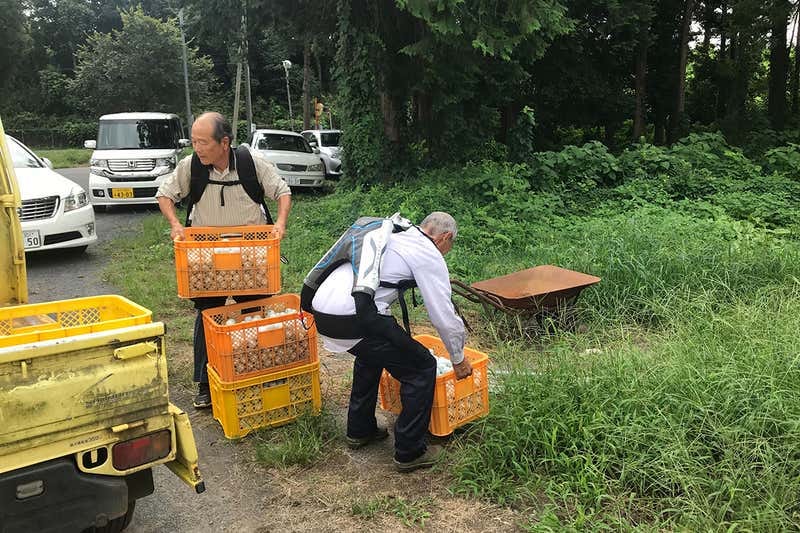CNBC profiled Axon Enterprise (one of my favourite stocks) in a piece titled “Taser-maker Axon is looking a lot more like Apple, Amazon, and so is the future of law enforcement”. The company recently hired Jeff Kunins from Amazon to oversee their product and software development roadmap.
Nintendo shares hit a 19-month high as the Switch became available for sale in China for the first time.
? Gaming
Do blockbuster movies or blockbuster games take more people to develop? Game publisher Casino Kings counted the credits of thousands of video game and movie titles to see how they compare.
Louis Vuitton launched a League of Legends apparel line which includes a $5,650 leather biker jacket and a $2,420 hoodie, which is a bit of a step-up from the $10 in-game character skins they launched back in October.
? Virtual and Augmented Reality
NFL team The Baltimore Ravens debuted a mixed-reality raven which was viewable by viewers at home and people watching the screens within the stadium. It was very reminiscent of the dragon at the 2017 League of Legends World Championship.
WSJ explores digital teleportation (also known as live delivery), which is the term for combining virtual reality, drones, and fast wireless networks so that you can experience far-off locations (through a drone) in real-time.
? Chips and Computing
We’ve discussed RISC-V architecture gaining traction several times before (Innovation Wrap #9, Innovation Wrap #11). Now Samsung have disclosed they’ll use RISC-V architecture in several modules in next year’s 5G smartphones, such as the 5G front-end RF modules and the AI image sensors. Previously these modules would be based on Arm’s architecture.
TSMC is on track to start 5nm commercial production in the 2nd half of 2020, and is expected to start 3nm volume production in 2022, according to JK Wang, the company’s senior vice president for fab operations.
ASML presented a slide with Intel’s planned 10-year roadmap at the IEEE International Electron Devices Meeting (IEDM). Intel expects to return to its 2-year cadence of process node improvements, with 5nm in 2023 (expected to be equivalent to TSMC’s 3nm) and 1.4nm in 2029.
? Blockchain and Crypto
China may be just about to launch its digital currency in two cities, Shenzhen and Suzhou. The digital currency electronic payment (DCEP) is meant to be a direct replacement for physical cash. It’s been estimated that mobile payments already made up more than 80% of all payments in China in 2018, up from less than 20% in 2013.
? Robotics and Drones
PrecisionHawk, a drones-as-a-service company, has raised $32 million in a Series E round, bringing their total funding to date to $136 million. The company provides remote sensing and data processing services in the agriculture, construction, mining, and energy industries.
Turkey decided that having drones with machine guns was a good idea.
A drone with a machine gun attached can hit targets with high precision, according to its makers. Turkey is set to become the first country to have the drone, when it gets a delivery this month.
The 25-kilogram drone has eight rotating blades to get it in the air. Its machine gun carries 200 rounds of ammunition and can fire single shots or 15-round bursts.
Russia’s Military of Defense is expected to start testing swarms of ground robots in the first half of 2020. Testing will centre on swarms of the Marker unmanned ground vehicle, which was originally unveiled in February.
? Augmented Humans
The US military is planning ahead about cyborg supersoldiers. A report titled “Cyborg Soldiers 2050: Human / Machine Fusion and the Implications for the Future of the DOD” includes four case studies for how soldiers could enhanced by machines in the future. The case studies looked at cybernetically enhanced eyes, optogenetic musculoskeletal control systems, auditory enhancements, and a direct interface between the human brain and machines. Poor public perception was highlighted as a barrier to mass adoption of cybernetics.
“Across popular social and open-source media, literature, and film, the use of machines to enhance the physical condition of the human species has received a distorted and dystopian narrative in the name of entertainment,” the study said. “Defense leadership should understand that negative public and social perceptions will need to be overcome, if these technologies are to be fielded.”
In Japan, some older people have started using exoskeletons to help them keep working as they age. An exoskeleton suit made by Daigo Orihara (pictured below) is worn like a backpack, weighs less than 4 kilograms, and makes it easier to lift and carry heavy objects.
? Cybersecurity
The City of New Orleans declared a state of emergency and shut down its computers after they detected ransomware in their systems. No requests for a ransom were made.
A hacker breached a Ring home security camera which is fairly unnerving from a privacy perspective, though the problem wasn’t with the device itself but rather lax password management, likely due to using insecure passwords across multiple sites.
In a bid to improve password security, Chrome will start automatically scanning your passwords against data breaches.
⚡ Other Snippets
Facebook unveiled the Deepfake Detection Challenge (DFDC) at NeurIPS 2019. It’s a competition set up by Facebook, AWS, Microsoft, and the Partnership on AI’s Media Integrity Steering Committee to identify videos with fake facial or voice manipulations from a dataset of 100,000 videos. The entry deadline is March 3, 2020, submissions close on March 31, 2020, and the competition has a prize pool of US$1 million (with US$500,000 to first place).
After SpaceX launched its first set of Starlink satellites in May, people noticed they were quite bright. Now the company is trying to make the satellites dimmer by testing an experimental coating that aims to make them less reflective and invisible to the naked eye.
China became the biggest producer of high-quality research in chemistry for the first time, unseating the United States, according to Nature Index.
Researchers in South Korea have created prototype solar cells that are as transparent as tinted glass by etching tiny holes in the material. Transparent solar cells could be used to replace windows in office blocks that have limited roof space for traditional solar.
Veritasium has put out a 21 minute video on how to slow and possibly reverse aging. The video is built around an interview with David Sinclair, professor of genetics at Harvard Medical School (see Innovation Wrap #11), so while it’s not particularly new, it’s still a fascinating topic.












